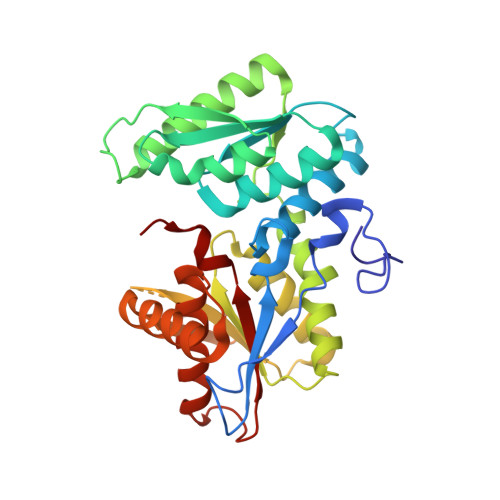Structural and functional characterization of beta-cyanoalanine synthase from Tetranychus urticae.
Daneshian, L., Renggli, I., Hanaway, R., Offermann, L.R., Schlachter, C.R., Hernandez Arriaza, R., Henry, S., Prakash, R., Wybouw, N., Dermauw, W., Shimizu, L.S., Van Leeuwen, T., Makris, T.M., Grbic, V., Grbic, M., Chruszcz, M.(2022) Insect Biochem Mol Biol 142: 103722-103722
- PubMed: 35063675
- DOI: https://doi.org/10.1016/j.ibmb.2022.103722
- Primary Citation of Related Structures:
6XO2, 7MFJ - PubMed Abstract:
Tetranychus urticae is a polyphagous spider mite that can feed on more than 1100 plant species including cyanogenic plants. The herbivore genome contains a horizontally acquired gene tetur10g01570 (TuCAS) that was previously shown to participate in cyanide detoxification. To understand the structure and determine the function of TuCAS in T. urticae, crystal structures of the protein with lysine conjugated pyridoxal phosphate (PLP) were determined. These structures reveal extensive TuCAS homology with the β-substituted alanine synthase family, and they show that this enzyme utilizes a similar chemical mechanism involving a stable α-aminoacrylate intermediate in β-cyanoalanine and cysteine synthesis. We demonstrate that TuCAS is more efficient in the synthesis of β-cyanoalanine, which is a product of the detoxification reaction between cysteine and cyanide, than in the biosynthesis of cysteine. Also, the enzyme carries additional enzymatic activities that were not previously described. We show that TuCAS can detoxify cyanide using O-acetyl-L-serine as a substrate, leading to the direct formation of β-cyanoalanine. Moreover, it catalyzes the reaction between the TuCAS-bound α-aminoacrylate intermediate and aromatic compounds with a thiol group. In addition, we have tested several compounds as TuCAS inhibitors. Overall, this study identifies additional functions for TuCAS and provides new molecular insight into the xenobiotic metabolism of T. urticae.
- Department of Chemistry and Biochemistry, University of South Carolina, Columbia, SC, 29208, USA.
Organizational Affiliation:


















